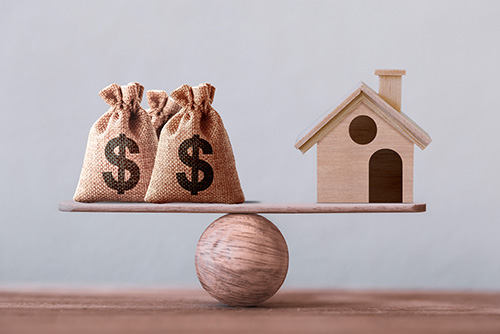Buying your first home is one of life’s milestone moments. After all, this is the place where you will eat family dinners, play catch in the yard, and entertain friends for many years to come.
And while owning a home is the quintessential American dream, first-time buyers should make certain they can afford the house they want to purchase before signing on the dotted line. When you own a home, there’s more than just the mortgage to pay every month, so it’s important to budget properly for your first mortgage. But how do you do that?
In this blog, we’ll walk you through budgeting for your first mortgage so that you can realize the dream of home ownership—without becoming “house poor” in the process!
What Is Being “House Poor?”
Being “house poor” means that you spend so much on the collective cost of owning a home every month that you have very little money left over for other important expenditures like saving for retirement, buying a new car, or even going out to dinner with friends.
A common mistake many first-time buyers make is that they purchase a house based on the biggest mortgage loan they’re offered, without considering the additional costs that come with home ownership.
The mortgage you get approved for could be a higher number than the mortgage you can reasonably afford. Therefore, it’s important to figure out, in advance, what that “reasonable” number is.
To do so, consider how much income you have every month, what expenses are being paid out, and how much you are saving. Then, follow the 28/36 Rule: don’t spend more than 28% of your gross monthly income on home-related costs (utilities, taxes, maintenance, etc.) and no more than 36% on all your debts combined like your mortgage, credit card bills, and car loans.
Calculate Monthly Expenses
The easiest way to budget for your mortgage is first to add up all of the other expenses that come with home ownership and then determine what size mortgage you can truly afford. Tally expenses like:
Property Taxes: Typically account for 15-20% of monthly housing costs
Insurance: Usually 5-10% of monthly housing costs
Utilities: Electricity, internet, cable, oil, water, gas; depending on your region, it can cost thousands of dollars in oil to heat a furnace through the winter months or in electricity to run air conditioning during the summer
Maintenance Costs: Can run the gamut from landscaping to snowplowing to furnace or air conditioning repair/replacement; Every year, try to save 1-2% of your home’s value to pay for maintenance and upkeep.
Home Owners Association (HOA) Fees: Private communities charge annual HOA fees which can be a few hundred to several thousand dollars, depending on the association.
Be Mindful of Other Expenses
As if all of that isn’t enough, there are other expenses you should consider when budgeting for your first mortgage. Unfortunate occurrences like broken water pipe repairs or the removal of trees that fall in the yard can be expensive, so it’s wise to set aside some money for those sudden, emergency expenditures.
On a happier note, you might need to buy some furniture, rugs, or televisions for your new home—so be sure to add those costs into your budget as well.
Closing Costs
Buyers should also be prepared to spend money on closing costs, which are fees incurred during the final stretch of the home-purchasing journey. These charges typically cost 3% to 6% of the purchase price and must be paid in full during the finalization (i.e. the closing) of the home purchase.
Create a Savings Plan for a Down Payment
When offering a mortgage loan, many lenders require the borrower to provide a minimum 20% down payment. If you can start saving for a down payment years before you intend to buy a house, you’ll have a stash of cash ready to hand over.
If you cannot afford a 20% down payment, the lender will require you to purchase private mortgage insurance, adding another monthly expense to the list.
- To jumpstart your down payment savings, consider doing the following:
- Automate a certain number of dollars from your paycheck every month into a special account that earns higher interest, like a money market or high-yield savings account.
- Temporarily change your savings goals so that a down payment is a top priority, and another goal is shifted to a lower priority status.
- Investigate down payment assistance programs offered through your state or local housing authority.
- Look into government-funded mortgage loans that have much smaller down payment requirements (as little as 3%) like FHA and USDA loans or some that have no down payment requirements at all, like VA loans for those who have served in the military.
- Cut out unnecessary expenses like streaming services or take-out food delivery and direct that money into your down payment savings account.
Let Homebase Help
Although buying your first home is one of life’s big, beautiful moments, it can also be stressful and a bit overwhelming.
So why not let Homebase help make the mortgage process smooth and seamless? Our Budgeting and Saving Calculators can help you create a home ownership budget that includes all of the costs related to mortgages and home ownership so you can figure out an affordable mortgage that suits your financial circumstances and lifestyle. Once your budget is in place, just click the button below to learn more about our mortgages and competitive rates.*
Homebase works closely with Member Advantage Mortgage (NMLS ID #1557), a full-service mortgage lender with an experienced staff offering honest professional advice, from purchase to refinance and everything in between. Member Advantage Mortgage offers a wide range of mortgage products at competitive rates.
*Subject to credit approval.



 Join Now
Join Now Contact Us
Contact Us  Branches & ATMs
Branches & ATMs Become a Member
Become a Member Make a Payment
Make a Payment Branches & ATMs
Branches & ATMs Contact Us
Contact Us
